
Beku BDFN Dishwasher
About Beku
In 1955, when our story began, white goods had only started to become a commonplace sight in every home. We have now developed into the most popular freestanding home appliance company in Europe.
We have concentrated on innovation over the last 20 years to improve the convenience and wellness of our clients’ lives. Our products’ useful innovations and ease of use have allowed us to become the fastest-growing brand in the European market.
Dear Customer,
Please read this user manual before using the product.
Thank you for choosing this Beko product. We hope that you get the best results from your product which has been manufactured with high quality and state-of-the-art technology. Therefore, please read this entire user manual and all other accompanying documents before using the product. Follow all warnings and information in the user manual. Thus, you can protect yourself and your product against potential dangers. Keep the user manual. If you hand over the product to someone else, give the user manual as well.
Safety Instructions
- This section contains safety instructions that will help protect you against risks of personal injury or property damage.
- Our company shall not be responsible for damages that may arise when these instructions are not followed.
Warning
- Installation and repair procedures must always be performed by the manufacturer, authorized service agent, or a qualified person specified by the importer.
- Only use original parts and accessories.
- Do not repair or replace any part of the product unless specified expressly in the user manual.
- Do not make any technical modifications to the product.
Intended Use
This product is designed to be used in houses and indoor places. For example:
- Personnel kitchens in stores, offices, and other working environments;
- Farm houses;
- Areas used by customers at hotels, motels, and other types of accommodation;
- Bed & breakfast type hotels, boardinghouses.
- The service life of your product is 10 years. During this period, original spare parts will be available to operate the product properly.
Safety for children, vulnerable persons and pets
- This product can be used by children at and above 8 years old and by persons whose physical, sensory, or mental capabilities were not fully developed or who lack experience and knowledge provided that they are supervised or trained on the safe usage of the product and the risks it brings out.
- Children below the age of 3 must be kept away from the product unless they are continuously supervised. Electrical products are dangerous for children and pets. Children and pets must not play with, climb on, or enter inside the product.
- Do not forget to close the door of the product when leaving the room where it is located. Children and pets may remain locked inside the product and suffocate.
- Cleaning and user maintenance work should not be performed by children unless they are supervised by someone.
- Keep packaging materials away from children. There is the risk of injury and suffocation. Store all detergents and additives used with the product in a safe place away from the reach of children.
- For children’s safety, cut the power cable and break the locking mechanism so that it will be non-functional before disposing of the product.
Electrical safety
- The product must be unplugged during installation, maintenance, cleaning, repair, and moving procedures.
- If the power cable is damaged, it must be replaced by a qualified person specified by the manufacturer, authorized service agent, or importer to avoid potential dangers.
- Do not squeeze the power cable under or behind the product. Do not place heavy objects on the power cable. The power cable must not be bent excessively, pinched, or come into contact with any heat sources.
- Do not use extension cords, multi-sockets, or adapters to operate the product.
- The plug must be easily accessible. If this is not possible, the electrical installation where the product is connected must contain a device that conforms to the electrical regulations and disconnects all poles from the grid.
- Do not touch the power plug with wet hands.
- Remove the plug from the socket by gripping the plug and not the cable.
Transportation Safety
- Before transporting the product unplug it and disconnect its drain and water supply connections. Drain the remaining water in the product completely. The product is heavy, do not move it alone.
NOTICE If you need to move the product, do it in an upright position and hold it from the rear side. Slanting the product to the front may cause the electronic parts in it to get wet and damaged.
Installation Safety
- To make the product ready for use, review the information in the user manual and installation instructions and make sure that the electricity, water supply, and drain systems are appropriate. If they are not, call a qualified technician and plumber to have the necessary arrangements carried out. These procedures are under the customer’s responsibility.
- Before installation, check if the product has any defects on it. If the product is damaged, do not have it installed.
- Do not install the product in environments where the temperature falls below 0ºC.
- If the product is going to be used inside a wardrobe/ cabinet/module, keep the doors of the wardrobe/cabinet/ module open during operation in cases where there are no openings to provide sufficient air circulation.
NOTICE You must use the new hose set provided with the product. Do not reuse the old hose set. Do not make extensions at the hoses.
Operational safety
- Only dishwasher-safe detergents, rinse aids and additives must be used.
- The wash water inside the product is not potable.
- When you pull the upper and lower baskets out completely, the door of the product will bear all the weight of the baskets. Do not sit or put other loads on the door; otherwise, the product may tilt.
The maximum washing capacity of the product is stated in the section called “Technical Specifications”.
Technical Specifications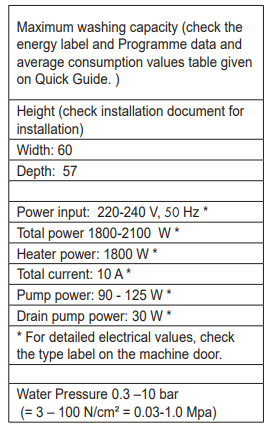
Instructions
Compliance with the WEEE Directive and Disposing of the Waste Product
This product complies with the EU WEEE Directive (2012/19/ EU). This product bears a classification symbol for waste electrical and electronic equipment (WEEE). This symbol indicates that this product shall not be disposed of with other household wastes at the end of its service life.
Compliance with RoHS Directive
The product you have purchased complies with the EU RoHS Directive (2011/65/EU). It does not contain harmful and prohibited materials specified in the Directive.
Package information
The packaging materials of the product are manufactured from recyclable materials by our National Environment Regulations. Do not dispose of the packaging materials together with the domestic or other wastes.
Your dishwasher
Overview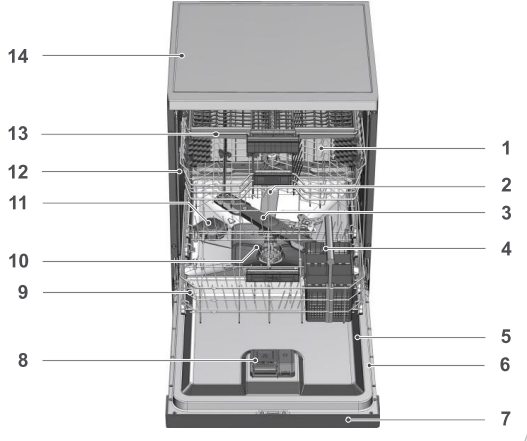
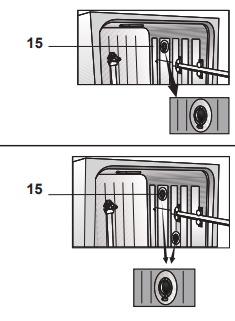
- Upper basket
- Upper impeller
- Lower impeller
- Cutlery basket (depends on model)
- Door
- Rating Label
- Control panel
- Detergent dispenser
- Lower basket
- Filters
- Salt reservoir lid
- Upper basket rail
- Upper cutlery basket (depends on model)
- Tabletop (depends on model)
- Fan drying system (depends on model)
Installation
Read the “Safety Instructions” section first! Installation procedures must always be performed by the manufacturer, authorized service agent, or a qualified person specified by the importer. To make the product ready for use, make sure that the electricity, tap water supply, and water drainage systems are appropriate before calling the authorized service agent. If they are not, call a qualified technician and plumber to have the necessary arrangements carried out.
Appropriate installation location
- Place the product on a solid and flat floor that has sufficient load-carrying capacity! The product must be installed on a flat surface for the door to be closed properly and securely.
- Do not install the product at places where the temperature may fall below 0ºC.
- Place the product on a hard floor. Do not place it on a long pile rug or similar surfaces
- Make sure that you select a location that will allow you to load and unload the dishes in a fast and comfortable manner. Install the product at a place close to the tap and the drain hole. Select the installation location by considering that it will not be changed after the connections are made
Connecting water supply
Permitted water temperature: up to 25°C ( 60°C for products equipped with Aquasafe+; please refer to Aquasafe+ section )
- The dishwasher may not be connected to open warm water devices or flow-through water heaters.
Connection to the drain
The water discharge hose can directly be connected to the drain hole or sink’s drainage. See the installation manual supplied with your machine for detailed information.
Adjusting the feet
If the door of the product cannot be closed properly or if the product rocks when you push it slightly, then you need to adjust the feet of the product. Adjust the feet of the product as illustrated in the installation manual supplied with the product.
Electrical connection
- Do not make connections via extension cables or multi-plugs.
- Damaged power cables must be replaced by the authorized service agent
Preparation
Tips for energy saving
The following information will help you use the product in an ecological and energy-efficient manner.
- Wipe away any coarse food remnants on the dishes before putting them in the product.
- Operate the product after filling it. When selecting a program, consider the table of “Programme data and average consumption values” given in Quick Guide. Do not put more detergent than suggested on the detergent package.
Water softening system
The product is equipped with a water softening system which reduces the hardness of incoming water. This system softens the supply water to a level that will allow washing the dishes with the required quality.
Adjusting the water-softening system
Washing performance will increase when the water softening system is adjusted properly. The regeneration of the water softening system can be done in all programs during the drying step. When regeneration occurs, the duration, energy, and water consumption of the program increase. For the regeneration process; the frequency of the regeneration cycle, maximum additional duration, and water, and energy consumption are given in the table below depending on the Eco 50°C program water consumption when the dishwasher is run under standard conditions with 14 dH water supply on its Eco 50°C program: For the water consumption of your dishwasher on Eco 50°C program, look at the Programme data and average consumption values table given on Quick Guide.
Adding salt
The water softening system needs to be regenerated for the product to operate with the same performance continuously. Dishwasher salt is used for this purpose.
- Use only special softening salts produced particularly for the dishwashers in your machine.
- It is recommended to use granule- or powder-formed softening salts in the water softening system. Do not use salts that do not completely dissolve in water such as table salt or rock salt. Otherwise, the performance of the system may deteriorate in time.
The salt reservoir will be filled with water when you start the product. For this reason, add salt before operating the machine.
- Firstly, take the lower basket out to add softening salt.
- Turn the salt reservoir lid counterclockwise to open it (A).
- Add 1 liter of water to the salt reservoir of your machine only in initial use.
- Fill the salt reservoir with salt by using the salt funnel (D). To speed up the dissolution rate of salt in water, stir it with a spoon. You can put about 2 kg of softening salt into the salt reservoir.
- Replace the lid and tighten it when the reservoir is full.
Detergent
You can use powder, liquid/gel, or tablet detergents in the machine.
- Only use detergents produced particularly for use with dishwashers. Note that detergents that contain chlorine and phosphate can be harmful to the environment. Liquid detergents
Adding detergent
- Pay attention to the warnings on the detergent packaging to get better washing and drying results. Contact the manufacturer of the detergent for further questions.
- Do not put solvents into the detergent dispenser. There is the risk of explosion! Put the detergent into the detergent dispenser just before operating the machine as illustrated below.
- Push the latch to the right to open the detergent dispenser lid (A). (depends on the model)
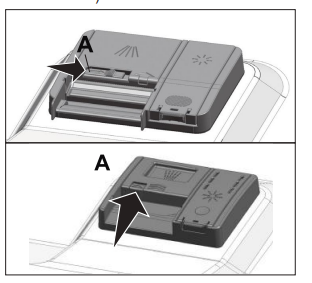
- Put the suggested amount of powder, liquid/gel, or tablet detergent in the reservoir.
- Push the lid of the detergent dispenser to close it. A “click” will be heard when the lid is closed.

Use powder or liquid/gel detergent in short programs without prewashing since the solubility of the tablet detergent changes depending on the
Tablet detergents
In addition to the conventional tablet detergents, there are also commercially available detergent tablets that show water-softening salt and/or rinse aid effects. Some types of these detergents contain special-purpose components such as glass and stainless steel protectors. These tablets show their effects up to a certain water hardness level (21°dH). Water softening salt and rinse aid must also be used together with the detergent if the water hardness level is above the mentioned level. The best washing performance in dishwashers is obtained by using detergent, rinse aid, and water-softening salt individually.
When you switch to powder detergent from tablet detergent:
- Make sure that salt and rinse aid reservoirs are full.
- Set the water hardness to the highest level and perform an empty run
- After the empty washing cycle, review the user manual and readjust the water hardness level to suit the water supply.
- Make the appropriate rinse aid settings.
Rinse aid
The rinse aid used in dishwashers is a special combination that aims to increase drying efficiency and prevent water or lime stains on the washed items. For this reason, care must be paid to have rinse aid in the rinse aid reservoir and to use rinse aids produced specially for dishwashers only.
- Open the lid of the rinse aid reservoir with the help of the latch.
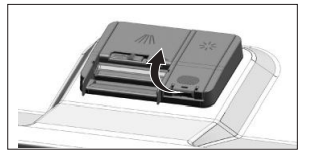
- Fill the reservoir until the “MAX” level.

- Slightly press the point (B) of the reservoir lid to close it.
- If there are stains on tableware items after washing, the level must be increased and if there is a blue trace after wiping them by hand, it must be decreased. This is set to position 3 as factory default.
Items not suitable for washing in the dishwasher
- Never wash dishes soiled by cigarette ash, candle remnants, polish, dyestuff, chemicals, etc. in your dishwasher.
- Do not wash silverware and cutlery with wooden or bone stems, glued pieces, or pieces that are not resistant to heat, as well as copper and tinplated containers in the dishwasher. washing especially in the dishwasher.
Placing the dishes into the dishwasher
Depending on the capacity of your dishwasher, you can use your dishwasher in an optimum way concerning energy consumption and washing and drying performance only if you place the dishes in an orderly way.
- Wipe away any coarse food remnants (bones, seeds, etc.) on the dishes before placing them in the dishwasher.
- Place thin, narrow pieces in the middle sections of baskets if possible.
- Place the heavily soiled and bigger items in the lower basket and smaller, delicate, and light items in the upper basket.
- Place the hollowed dishes such as bowls, glasses and pans upside down in the dishwasher. Thus, the accumulation of water in deep hollows is prevented.
Suggestions for loading the dishwasher
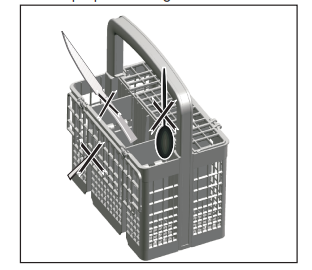
Cutlery basket
(depends on the model) The cutlery basket is designed to wash your dishes such as knives, forks, spoons, etc. efficiently. Since the cutlery basket can be moved (A, B), you can create more space while placing your dishes in the lower basket and free up space for your dishes of different sizes.
 Tray Wash Supports
Tray Wash Supports
(depends on the model) Use the supports to wash trays in the bottom basket. See the Auxiliary functions section for the appropriate program and function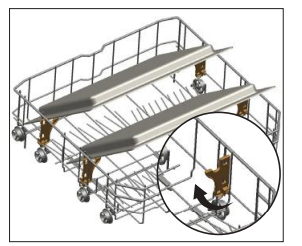
SoftTouch Accessory
(depends on the model) The SoftTouch Accessory found in the lower basket of your machine enables safe washing for your fragile glasses.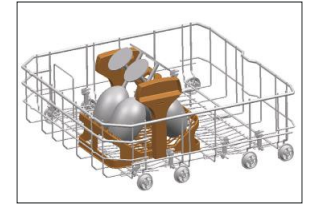
Lower basket multipurpose / height adjustable service rack
(depends on the model) This accessory located at the lower basket of your machine allows you to easily wash pieces such as extra glasses, long ladles, and bread knives.
To close the racks:
- Fold the rack (A).
- Slide the rack up (B).
- Put the rack in a vertical position (C).
- Slide the rack down and lock it by the tabs (D).
Maintenance and cleaning
The service life of the product extends and frequently faced problems decrease if it is cleaned at regular intervals.
Cleaning the outer surface of the product
NOTICE Clean the outer surface and door gaskets of the product gently with a mild cleaning material and damp cloth. Wipe the “control panel” only with a damp cloth.
Cleaning the interior of the machine
- Clean the interior of the machine by operating the machine in the program running at the highest possible temperature with detergent or special machine cleaning agents monthly. This operation will help remove leftovers and limescale from the interior of the machine.
- If water has remained in the machine, drain the water by performing the procedures under the topic “Cancelling a program”. If the water cannot be discharged, remove the filters as specified in the “Cleaning the filters” section and check if there are any leftover deposits that have accumulated at the bottom of the machine, blocking the water path. Clean if necessary.
Cleaning the filters
Clean the filters at least once a week for the machine to operate efficiently. The food residues are left on the filters. If there are food residues on filters, take them out and clean them well under running water.
- Turn the microfilter (1) and coarse filter (2) assembly counterclockwise and pull it out from its seating. (depending on the model)
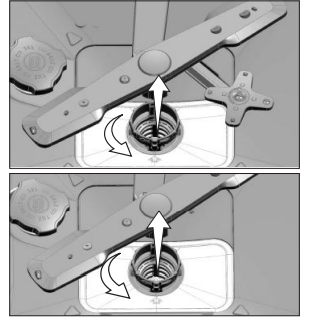
- Pull out the metal/plastic filter (3) from the seating.
- Press the two pawls on the coarse filter inwards and separate the coarse filter from the assembly.
- Clean all three filters under tap water using a brush.
- Place the metal/plastic filter.
- Place the coarse filter into the microfilter. Make sure that it is properly seated. Turn the coarse filter clockwise until a “click” sound is heard.
Cleaning the hose filter
Damages on the machine that may be caused by impurities coming from the urban supply water or your water installation (such as sand, dirt, rust, etc.) can be prevented using the filter attached to the water inlet hose. Check the filter and the hose regularly and clean them if necessary.
- Turn off the tap and remove the hose.
- After taking out the filter, clean it under running tap water.
- Place the cleaned filter back to its seat in the hose.
- Install the hose to the tap.
Cleaning the impellers
- Clean the impellers at least once a week for the machine to operate efficiently.
Lower impeller
- Check if the holes on the lower impeller (1) are clogged. If they are clogged, remove and clean the impeller. You can pull the lower impeller up to remove it.
- To remove and clean the lower impeller assembly together, hold one hand from the (C) points shown in the figure and pull up to remove. After cleaning, follow these steps in reverse order to reinstall the impeller assembly.
- Do not try to rotate the impeller by holding its ends. Trying to rotate the end sections may cause the gear system within the impeller to break.
Upper impeller
- Check if the holes on the upper impeller (1) are clogged. If they are clogged, remove and clean the impeller. Turn its nut to the left to remove the upper impeller. Make sure that the nut is tightened well when installing the upper impeller.
Troubleshooting
The machine does not start.
- The power cable is unplugged. >>> Check if the power cable is plugged in.
- The fuse is blown. >>> Check the fuses in your house.
- Water is cut. >>> Make sure that the water inlet tap is open.
- The door of the machine is open. >>> Make sure that you have closed the door of the machine.
- The on / Off button is not pressed. >>> Make sure that you have turned on the machine by pressing the On / Off button.
Dishes are not washed clean
- Dishes are not placed orderly in the machine. >>> Load the dishes as described in the user manual.
- The selected program is unsuitable. >>> Select a program with a higher temperature and cycle time.
- Impellers are stuck. >>> Before starting the program, turn the lower and upper impellers by hand to make sure that they rotate freely.
- Impeller holes are clogged. >>> Lower and upper impeller holes might be clogged with food remnants such as lemon pips. Clean the impellers regularly as illustrated in the section “Cleaning and Care”.
- Filters are clogged. >>> Check if the filter system is clean. Clean the filter system regularly as illustrated in the section “Cleaning and Care”.
- Filters are installed incorrectly. >>> Check the filter system and make sure that it is installed correctly.
- Baskets are overloaded. >>> Do not overload the baskets over their capacity.
- Detergent is stored under unsuitable conditions. >>> If you are using powder detergent, do not store the detergent package in humid places. Keep it in a closed container if possible. For ease of storage, we recommend you use tablet detergents.
- Detergent is not sufficient. >>> If you are using powder detergent, adjust the amount of detergent according to the soiling degree of your dishes and/or program definitions. We recommend you use tablet detergents for optimum results.
- Rinse aid is not sufficient. >>> Check the rinse aid indicator and add rinse aid if necessary. Increase the setting if there is enough amount of rinse aid in the machine.
- The detergent dispenser lid is left open. >>> Make sure that the detergent dispenser lid is closed tightly after adding the detergent.
Dishes are not dry at the end of the cycle
- Dishes are not placed orderly in the machine. >>> Place your dishes in a way that no water will accumulate in them.
- Rinse aid is not sufficient. >>> Check the rinse aid indicator and add rinse aid if necessary. In the rinse aid setting if there is enough amount of rinse aid in the machine.
- The machine is unloaded right after the program is over. >>> Do not unload your machine right after the washing process is completed. Slightly open the door and wait for evacuation of the steam inside for a while. Unload the dishes after the pieces cool down to a touchable level. Start the unloading process from the lower basket. Thus, dropping of water remaining on a piece in the upper basket onto the pieces in the lower basket is prevented.
- The selected program is unsuitable. >>> Since the rinsing temperature is low at programs with short duration, drying performance will also be low. Select programs with longer duration for higher drying performance.
- The surface quality of the kitchen utensils is deteriorating. >>> Desired washing performance can not be obtained on kitchen utensils with deteriorated surfaces and it is not suitable to use such utensils in terms of hygiene as well. Also, water can not flow easily on deteriorated surfaces. It is not recommended to wash such kitchen utensils in a dishwasher.
Normally, drying complaints can be experienced with Teflon kitchen utensils. It is associated with the structure of Teflon. Since the surface tensions of Teflon and water are different, water droplets will remain as beads on the Teflon surface.
Tea, coffee, or lipstick stains remain on dishes.
- The selected program is unsuitable. >>> Select a program with a higher temperature and cycle time.
- The surface quality of the kitchen utensils is deteriorating. >>> Tea and coffee stains or other dye spots may not be cleaned in the dishwasher when they have penetrated deteriorated surfaces. Desired washing performance can not be obtained on kitchen utensils with deteriorated surfaces and it is not suitable to use such utensils in terms of hygiene as well. It is not recommended to wash such kitchen utensils in a dishwasher.
- Detergent is stored under unsuitable conditions. >>> If you are using powder detergent, do not store the detergent package in humid places. Keep it in a closed container if possible. For ease of storage, we recommend you use tablet detergents.
Lime traces remain on dishes and glassware gains a misty appearance
- Rinse aid is not sufficient. >>> Check the rinse aid indicator and add rinse aid if necessary. Increase the setting if there is enough amount of rinse aid in the machine.
- The water hardness setting is low or the salt level is insufficient >>> Measure the hardness of the supply water appropriately and check the water hardness setting.
- Salt leakage exists. >>> Pay attention not to spill salt around the salt-filling hole while adding salt. Make sure that the salt reservoir lid is tightly closed after finishing the filling process. Run the prewash program to remove the salt that spilled inside the machine. Since the salt granules that will remain under the lid will dissolve during prewash, causing the lid to loosen, check the lid once again at the end of the program.
There is a different odor in the machine
A new machine has a peculiar odor. It will fade out after a couple of washes.
- Filters are clogged. >>> Check if the filter system is clean. Clean the filter system regularly as illustrated in the section “Cleaning and Care”.
- Dirty dishes are kept in the dishwasher for 2-3 days. >>> If you are not going to start the machine right after you have put the dishes into it, remove the remnants on the dishes and run the Prewash program without detergent every 2 days. In such cases, do not close the door of the machine completely to avoid odor buildup in the machine. You can also use commercially available odor removers or machine cleaners.
Rust, discoloration, or surface deterioration occurs on dishes
- Salt leakage exists. >>> Salt may cause deterioration and oxidation on metal surfaces. Pay attention not to spill salt around the salt-filling hole while adding salt. Make sure that the salt reservoir lid is tightly closed after finishing the filling process. Run the prewash program to remove the salt that spilled inside the machine. Since the salt granules that will remain under the lid will dissolve during prewash, causing the lid to loosen, check the lid once again at the end of the program.
- Salty food remnants have remained on dishes for a long time. >>> If cutlery soiled with such foods will be kept waiting in the machine, dirt must be removed by prewash or dishes must be washed without being kept waiting.
- Electric installation is not grounded. >>>Check if your machine is connected to the actual grounding line. Otherwise, the static electricity created in the product causes arcs on the surfaces of metal items creating pores, removing the protective cover on the surface, and causing discoloration.
- Intensive cleansers such as bleaches are used. >>> Protective cover on metal surfaces gets damaged and loses its efficiency in time when it gets in contact with cleansers such as bleach. Do not wash your dishes with bleach.
- Metal items particularly knives are used for purposes other than their intended uses. >>> Protective cover on the edges of knives may get damaged when they are used for purposes such as opening cans. Do not use metal kitchen utensils out of their intended uses.
- Cutlery is made of low-quality stainless steel. >>> Corrosion on such items is inevitable; they should not be washed in dishwashers.
- Kitchen utensils that are already corroded are washed in the dishwasher. >>> Rust on a corroded item can migrate to other stainless steel surfaces and cause corrosion on those surfaces as well. Such items should not be washed in dishwashers.
Detergent remains in the detergent dispenser.
- The detergent dispenser was damp when adding detergent. >>> Make sure that the detergent dispenser is dried well before filling it with detergent.
- Detergent is added long before the washing process. >>> Pay attention to adding detergent shortly before the start-up of the washing.
- Opening of the detergent dispenser lid is prevented during washing. >>> Place the dishes in a way that will not prevent the detergent dispenser lid from opening and the water going into the machine from impellers.
- Detergent is stored under unsuitable conditions. >>> If you are using powder detergent, do not store the detergent package in humid places. Keep it in a closed container if possible. For ease of storing, we recommend you use tablet detergents.
- Impeller holes are clogged. >>> Lower and upper impeller holes might be clogged with food remnants such as lemon pips. Clean the impellers regularly as illustrated in the section “Cleaning and Care”.
Decorations and ornaments on kitchen utensils are being erased.
Decorated glasses and decorated luster porcelains are not suitable for washing in the dishwasher. Manufacturers of some glassware and porcelain tableware items do not recommend washing such kitchen utensils in the dishwashers either.
Dishes are scratched.
Kitchen utensils that contain or are made of aluminum should not be washed in the dishwasher.
- Salt leakage exists. >>> Pay attention not to spill salt around the salt-filling hole while adding salt. Spilled salt can cause scratches. Make sure that the salt reservoir lid is tightly closed after finishing the filling process. Run the prewash program to remove the salt that spilled inside the machine. Since the salt granules that will remain under the lid will dissolve during prewash, causing the lid to loosen, check the lid once again at the end of the program.
- The water hardness setting is low or the salt level is insufficient >>> Measure the hardness of the supply water appropriately and checks the water hardness setting.
- Dishes are not placed orderly in the machine. >>> When placing the glasses and other glassware into the basket lean them not against other dishes but the edges or racks of the basket or the glass support tines. Striking of the glasses to each other or other dishes due to the impact of water during washing can cause breaks or scratches on their surfaces.
A smear remains on glasses resembling a milk stain, which can not be removed by hand. A bluish / rainbow appearance occurs when the glass is pointed to light.
- Excessive rinse aid is used. >>>Lower rinse aid setting. Clean the spilled rinse aid when adding rinse aid.
- Corrosion has occurred on glass due to soft water. >>> Measure the hardness of the supply water appropriately and check the water hardness setting. If your supply water is soft (<5 dH), do not use salt. Choose programs that wash in higher temperatures (e.g. 60-65°C). You can also use glass protective detergents that are commercially available.
Foam forms in the machine.
- Dishes are washed with hand-wash detergent by hand but not rinsed before placing them into the machine. >>> Hand-wash detergents do not contain antifoam. There is no need to hand-wash the dishes before placing them into the machine. Removing the coarse soil on the dishes under tap water, with tissue paper or a fork will be sufficient.
- The rinse aid has spilled into the machine when adding the rinse aid. >>> Take care that the rinse aid is not spilled in the machine when you are filling it. Clean any spilled rinse it with the help of a tissue paper/towel.
- The lid of the rinse aid reservoir is left open. >>> Make sure that the lid of the rinse aid reservoir is closed after adding the rinse aid.
The kitchen utensils are broken.
- Dishes are not placed orderly in the machine. >>> Load the dishes as described in the user manual.
- Baskets are overloaded. >>> Do not overload the baskets over their capacity.
Water remains in the dishwasher at the end of the program.
- Filters are clogged. >>> Check if the filter system is clean. Clean the filter system regularly as illustrated in the section “Cleaning and Care”.
- The discharge hose is clogged/blocked. >>> Check the discharge hose. If necessary, remove the discharge hose, clear the blockage, and insert it as illustrated in the user manual.
If you cannot eliminate the problem although you follow the instructions in this section, consult your dealer or the Authorised Service Agent. Never try to repair a nonfunctional product yourself.
FAQS About Beku BDFN Dishwasher
How do I install the Beku BDFN Dishwasher?
Typically, dishwashers come with installation instructions in the user manual. Make sure to follow the step-by-step guide provided by the manufacturer.
What are the dimensions of the Beku BDFN Dishwasher?
Check the product manual or the manufacturer’s website for information on the dimensions of the dishwasher. This is important for fitting it into your kitchen space.
How do I load dishes into the dishwasher?
The user manual usually provides guidance on how to load dishes efficiently for optimal cleaning. It’s essential to follow the recommended loading instructions.
What detergent should I use with the Beku BDFN Dishwasher?
Dishwasher detergents can vary. Refer to the user manual for recommendations on the type and amount of detergent to use for your specific dishwasher.
How do I clean and maintain the dishwasher?
Regular maintenance is crucial for the dishwasher’s performance. Follow the maintenance guidelines in the user manual, which may include cleaning the filter, spray arms, and door gasket.
Why is the dishwasher not cleaning dishes properly?
Issues with cleaning performance can be due to various reasons, such as improper loading, clogged spray arms, or a malfunctioning component. Check the troubleshooting section of the user manual for guidance.
How do I troubleshoot common issues with the Beku BDFN Dishwasher?
The user manual often includes a troubleshooting section with solutions for common problems. Follow the provided steps to identify and address issues.
Can I use the dishwasher for all types of dishes?
Some items may not be dishwasher safe. Check the user manual for guidance on what types of dishes and materials are suitable for the dishwasher.
Is the Beku BDFN Dishwasher energy-efficient?
Look for information on the dishwasher’s energy efficiency in the product specifications or user manual. Energy efficiency ratings are often provided.
What is the warranty on the Beku BDFN Dishwasher?
Warranty information is typically included in the user manual or on the manufacturer’s website. Be sure to register your appliance and understand the warranty terms.
For more manuals by Beku ManualsDock


